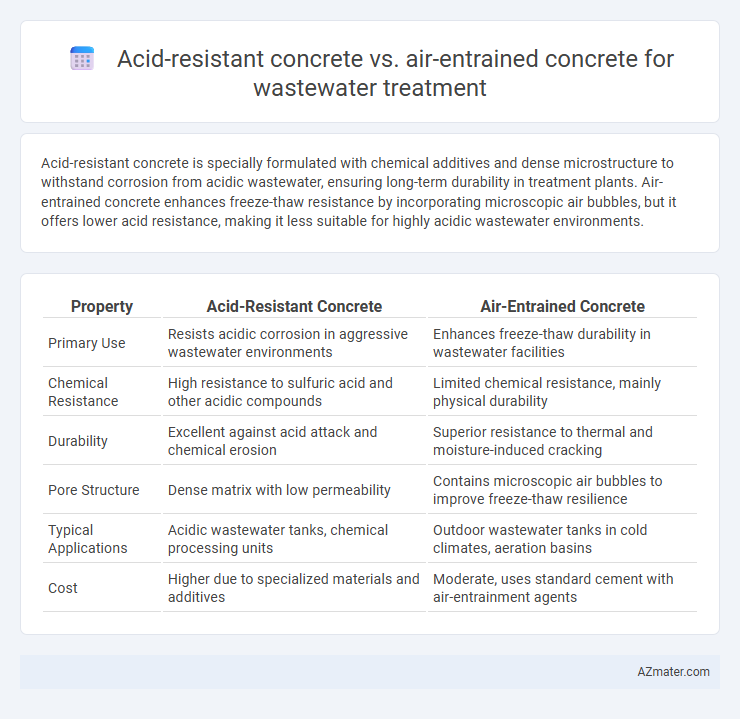Acid-resistant concrete is specially formulated with chemical additives and dense microstructure to withstand corrosion from acidic wastewater, ensuring long-term durability in treatment plants. Air-entrained concrete enhances freeze-thaw resistance by incorporating microscopic air bubbles, but it offers lower acid resistance, making it less suitable for highly acidic wastewater environments.
Table of Comparison
| Property | Acid-Resistant Concrete | Air-Entrained Concrete |
|---|---|---|
| Primary Use | Resists acidic corrosion in aggressive wastewater environments | Enhances freeze-thaw durability in wastewater facilities |
| Chemical Resistance | High resistance to sulfuric acid and other acidic compounds | Limited chemical resistance, mainly physical durability |
| Durability | Excellent against acid attack and chemical erosion | Superior resistance to thermal and moisture-induced cracking |
| Pore Structure | Dense matrix with low permeability | Contains microscopic air bubbles to improve freeze-thaw resilience |
| Typical Applications | Acidic wastewater tanks, chemical processing units | Outdoor wastewater tanks in cold climates, aeration basins |
| Cost | Higher due to specialized materials and additives | Moderate, uses standard cement with air-entrainment agents |
Introduction to Concrete Types in Wastewater Treatment
Acid-resistant concrete is specially formulated with chemical additives and dense microstructure to withstand harsh acidic environments common in wastewater treatment plants. Air-entrained concrete incorporates microscopic air bubbles to improve freeze-thaw durability and reduce cracking caused by frost exposure, enhancing structural longevity in wet conditions. Both concrete types play critical roles in wastewater treatment by addressing unique challenges such as chemical corrosion and physical weathering.
Defining Acid-Resistant Concrete: Composition and Purpose
Acid-resistant concrete for wastewater treatment is formulated with specialized cementitious materials, such as silica fume and acid-resistant aggregates, to withstand aggressive acidic environments and prevent structural degradation. Its composition typically includes low calcium content to minimize chemical reactions with sulfuric acid and other corrosive agents commonly found in wastewater. This concrete is purpose-built to extend the lifespan of infrastructure by resisting acid attacks that cause conventional concrete to deteriorate rapidly.
What is Air-Entrained Concrete? Key Features and Benefits
Air-entrained concrete contains microscopic air bubbles introduced during mixing, enhancing its resistance to freeze-thaw cycles and improving durability in harsh environments. Key features include increased workability, reduced permeability, and enhanced resistance to scaling caused by water and chemical exposure. These benefits make air-entrained concrete particularly suitable for wastewater treatment facilities where cyclical moisture and temperature variations are common.
Chemical Resistance: Performance in Harsh Wastewater Environments
Acid-resistant concrete demonstrates superior chemical resistance by withstanding low pH levels and aggressive acidic compounds commonly found in wastewater treatment environments, significantly reducing deterioration and structural damage. In contrast, air-entrained concrete offers enhanced freeze-thaw resistance but exhibits limited protection against strong acids and corrosive chemicals, leading to potential surface degradation over time. Wastewater facilities facing high concentrations of sulfuric acid or other corrosive agents benefit more from acid-resistant concrete formulations designed specifically to endure such harsh chemical exposure.
Durability and Longevity: Comparative Analysis
Acid-resistant concrete demonstrates superior durability in wastewater treatment environments due to its enhanced resistance against chemical attack from low pH fluids and sulfuric acid produced by microbial activity, significantly reducing material degradation and extending service life. Air-entrained concrete, while effective in improving freeze-thaw resistance and mitigating cracking caused by temperature fluctuations, offers limited protection against acidic corrosion, leading to accelerated deterioration under acidic wastewater conditions. Comparative analysis highlights acid-resistant concrete as the optimal choice for longevity in aggressive wastewater environments, whereas air-entrained concrete is better suited for structures subjected primarily to physical weathering stresses.
Structural Performance: Strength and Load-Bearing Capacity
Acid-resistant concrete exhibits superior chemical durability and maintains compressive strength in highly acidic environments typical of wastewater treatment plants, ensuring long-term structural integrity. Air-entrained concrete enhances freeze-thaw resistance but may experience slightly lower compressive strength compared to acid-resistant types, potentially limiting load-bearing capacity under harsh chemical exposure. Selecting acid-resistant concrete optimizes strength retention and structural performance against corrosive wastewater conditions, while air-entrained concrete primarily mitigates damage from thermal cycling without significantly improving chemical resistance.
Maintenance Requirements and Life Cycle Costs
Acid-resistant concrete in wastewater treatment facilities requires less frequent maintenance due to its superior resistance to chemical corrosion from acidic byproducts, significantly reducing repair costs and downtime. Air-entrained concrete, while effective against freeze-thaw cycles, demands more regular inspection and maintenance to address acid-induced surface degradation, increasing overall life cycle expenses. The higher upfront cost of acid-resistant concrete is offset by its longer service life and lower maintenance frequency, making it more cost-effective for wastewater environments with high acid exposure.
Installation and Curing: Practical Considerations
Acid-resistant concrete requires precise mixing and longer curing times to ensure chemical durability against aggressive wastewater environments, demanding controlled temperature and moisture conditions during installation. Air-entrained concrete, designed to improve freeze-thaw resistance and workability, allows for faster installation but necessitates careful air content control and curing to maintain structural integrity. Proper curing practices for both types are essential to achieve optimal performance, with acid-resistant concrete focusing on chemical stabilization, while air-entrained concrete emphasizes physical durability.
Environmental Impact and Sustainability Factors
Acid-resistant concrete is specifically formulated to withstand corrosive environments in wastewater treatment plants, reducing the need for frequent repairs and thus minimizing resource consumption over time. Air-entrained concrete enhances freeze-thaw durability and reduces permeability, which contributes to extended structural lifespan and less environmental degradation due to leakage or contamination. Selecting acid-resistant concrete often results in lower chemical use and longer service life, promoting sustainability by reducing maintenance frequency and associated carbon emissions.
Choosing the Right Concrete for Wastewater Treatment Facilities
Acid-resistant concrete offers superior durability and chemical resistance against the corrosive byproducts commonly found in wastewater treatment facilities, making it ideal for environments exposed to acidic conditions. Air-entrained concrete enhances freeze-thaw durability and reduces cracking but lacks sufficient resistance to aggressive acids and chemicals typically present in wastewater. Selecting the appropriate concrete involves assessing exposure to acidic agents, where acid-resistant formulations provide long-term structural integrity, while air-entrained concrete suits applications prioritizing freeze-thaw resilience over chemical resistance.

Infographic: Acid-resistant concrete vs Air-entrained concrete for Wastewater treatment
 azmater.com
azmater.com